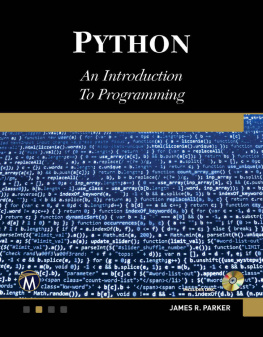James R Parker - Introduction to Game Development: Using Processing
Here you can read online James R Parker - Introduction to Game Development: Using Processing full text of the book (entire story) in english for free. Download pdf and epub, get meaning, cover and reviews about this ebook. year: 2015, publisher: Mercury Learning and Information, genre: Romance novel. Description of the work, (preface) as well as reviews are available. Best literature library LitArk.com created for fans of good reading and offers a wide selection of genres:
Romance novel
Science fiction
Adventure
Detective
Science
History
Home and family
Prose
Art
Politics
Computer
Non-fiction
Religion
Business
Children
Humor
Choose a favorite category and find really read worthwhile books. Enjoy immersion in the world of imagination, feel the emotions of the characters or learn something new for yourself, make an fascinating discovery.
- Book:Introduction to Game Development: Using Processing
- Author:
- Publisher:Mercury Learning and Information
- Genre:
- Year:2015
- Rating:4 / 5
- Favourites:Add to favourites
- Your mark:
- 80
- 1
- 2
- 3
- 4
- 5
Introduction to Game Development: Using Processing: summary, description and annotation
We offer to read an annotation, description, summary or preface (depends on what the author of the book "Introduction to Game Development: Using Processing" wrote himself). If you haven't found the necessary information about the book — write in the comments, we will try to find it.
Introduction to Game Development: Using Processing — read online for free the complete book (whole text) full work
Below is the text of the book, divided by pages. System saving the place of the last page read, allows you to conveniently read the book "Introduction to Game Development: Using Processing" online for free, without having to search again every time where you left off. Put a bookmark, and you can go to the page where you finished reading at any time.
Font size:
Interval:
Bookmark:

I NTRODUCTION T O
G AME D EVELOPMENT
U SING P ROCESSING
LICENSE, DISCLAIMER OF LIABILITY, AND LIMITED WARRANTY
By purchasing or using this book (the Work), you agree that this license grants permission to use the contents contained herein, but does not give you the right of ownership to any of the textual content in the book or ownership to any of the information or products contained in it. This license does not permit uploading of the Work onto the Internet or on a network (of any kind) without the written consent of the Publisher. Duplication or dissemination of any text, code, simulations, images, etc. contained herein is limited to and subject to licensing terms for the respective products, and permission must be obtained from the Publisher or the owner of the content, etc., in order to reproduce or network any portion of the textual material (in any media) that is contained in the Work.
M ERCURY L EARNING AND I NFORMATION (MLI or the Publisher) and anyone involved in the creation, writing, or production of the companion disc, accompanying algorithms, code, or computer programs (the software), and any accompanying Web site or software of the Work, cannot and do not warrant the performance or results that might be obtained by using the contents of the Work. The author, developers, and the Publisher have used their best efforts to insure the accuracy and functionality of the textual material and/or programs contained in this package; we, however, make no warranty of any kind, express or implied, regarding the performance of these contents or programs. The Work is sold as is without warranty (except for defective materials used in manufacturing the book or due to faulty workmanship).
The author, developers, and the publisher of any accompanying content, and anyone involved in the composition, production, and manufacturing of this work will not be liable for damages of any kind arising out of the use of (or the inability to use) the algorithms, source code, computer programs, or textual material contained in this publication. This includes, but is not limited to, loss of revenue or profit, or other incidental, physical, or consequential damages arising out of the use of this Work.
The sole remedy in the event of a claim of any kind is expressly limited to replacement of the book, and only at the discretion of the Publisher. The use of implied warranty and certain exclusions vary from state to state, and might not apply to the purchaser of this product.
I NTRODUCTION T O
G AME D EVELOPMENT
U SING P ROCESSING
J AMES R. P ARKER

Copyright 2015 by M ERCURY L EARNING AND I NFORMATION LLC. All rights reserved.
This publication, portions of it, or any accompanying software may not be reproduced in any way, stored in a retrieval system of any type, or transmitted by any means, media, electronic display or mechanical display, including, but not limited to, photocopy, recording, Internet postings, or scanning, without prior permission in writing from the publisher.
Publisher: David Pallai
M ERCURY L EARNING AND I NFORMATION
22841 Quicksilver Drive
Dulles, VA 20166
info@merclearning.com
www.merclearning.com
(800) 232-0223
James R. Parker. Introduction To Game Development Using Processing.
ISBN: 978-1-937585-40-2
The publisher recognizes and respects all marks used by companies, manufacturers, and developers as a means to distinguish their products. All brand names and product names mentioned in this book are trademarks or service marks of their respective companies. Any omission or misuse (of any kind) of service marks or trademarks, etc. is not an attempt to infringe on the property of others.
Library of Congress Control Number: 2015934495
151617321 This book is printed on acid-free paper.
Our titles are available for adoption, license, or bulk purchase by institutions, corporations, etc.
For additional information, please contact the Customer Service Dept. at 800-232-0223(toll free).
All of our titles are available in digital format at authorcloudware.com and other digital vendors. Companion files (figures and code listings) for this title are available by contacting info@merclearning.com. The sole obligation of M ERCURY L EARNING AND I NFORMATION to the purchaser is to replace the disc, based on defective materials or faulty workmanship, but not based on the operation or functionality of the product.
To Reni.
Thanks for everything.
CONTENTS
This book has taken longer to write than anticipated, but would have taken even longer without the help of a few key folks. Thanks go out: to Matthius Kabel for his panoramic image; to Herminio Nieves for the use of his Cycle model; to NASA for having the generosity to allow their images to be used by others; to my old friends at Radical Entertainment for g-etting me started, to Damien Di Fede for Minim ; and, of course, to the developers of Processing : Ben Fry, Casey Reas, and a host of others.
Games have been a subject of fascination for students for well over a decade. There are now thousands of people studying video game development at universities in North America alone, either as part of a formal game development degree or as a part of another program. Games can be used to teach, to convince, to sell, and simply to enjoy, and all have the same basic underlying structure as software and as media objects. Any computer game has the same essential structure: they use images and sounds, have objects that interact visually on the screen, and repeatedly update the display many times per second according to the simulated situation. There are some very advanced systems for game development available on the Internet, some being free and some for sale, but underneath they all help accomplish very similar tasks.
This book is intended to provide game development students with the insights into how games function that are an essential starting point for further study. Each of the chapters focuses on a particular aspect of game development, from graphics to audio to artificial intelligence to animation, and does so in a very hands-on way. For people with little programming background Appendix B gives a quick introduction to Processing with some basic examples. Appendix A illustrates some of the common mathematics techniques used in building games. There is a lot of code on the companion disk, including three complete games: a 2D arcade style game named Hockey Pong , a 3D submarine game named SMV Rainbow , and a puzzle game for Android. These are examples, but are fully functional and show how to deal with many of the typical problems one would normally encounter in a game development project.
The language Processing is used because it provides a visual output very easily it was designed for art students while having access to the full power of Java. Almost anyone in a development team could learn Processing and appreciate the game principles that are described using that language. Its also possible to build quite interesting games in Processing , games that can run on personal computers, on the Internet through browsers, and as Android apps.
The subject of gamification is not pursued in this book specifically, but the material here can be used in implementing gamified interfaces and systems. After all, running Processing on a Web page is spectacularly easy.
A computer game is a microcosm of the discipline of computer science. A game contains within it many of the problems one would study in a computer science degree program, and a small set of games could encompass nearly every concept a CS degree would present. Its an entertaining way to learn the subject, not just programming but artificial intelligence, interfaces, graphics, and design. So read, modify the code, add new art, and have fun if you are not having fun, youre doing it wrong.
Next pageFont size:
Interval:
Bookmark:
Similar books «Introduction to Game Development: Using Processing»
Look at similar books to Introduction to Game Development: Using Processing. We have selected literature similar in name and meaning in the hope of providing readers with more options to find new, interesting, not yet read works.
Discussion, reviews of the book Introduction to Game Development: Using Processing and just readers' own opinions. Leave your comments, write what you think about the work, its meaning or the main characters. Specify what exactly you liked and what you didn't like, and why you think so.













